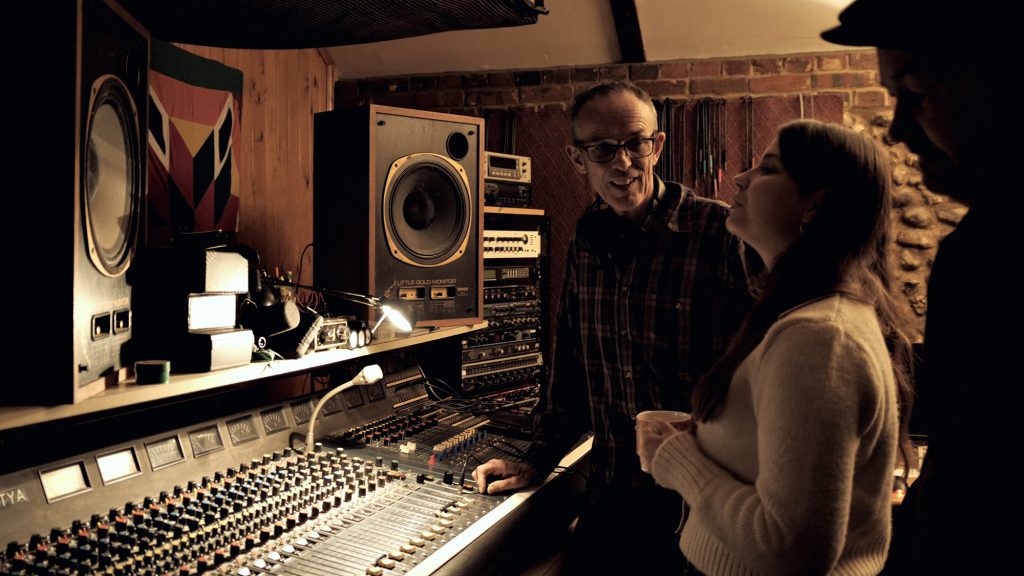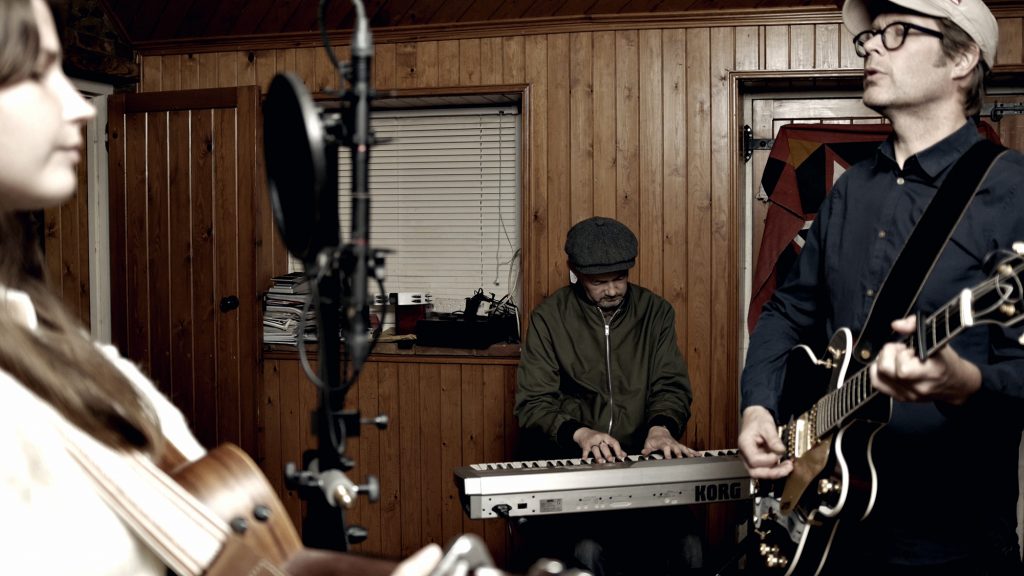
With a pair of the final production versions of the BD-10s in hand, I thought it was high time that I followed up my earlier studio tests of the mics in a Blumlein pair with some field recordings. It’s not often you come across Blumlein pairs (or, indeed, mid-side pairs with two fig 8s) used for anything but music recording. I suspect this has to do with two different things: first, field recordists rarely have multiple fig 8s, perhaps only having one for mid-side recording; and, second, I wonder whether there is a bit of concern about the inversion of the rear ‘image’ of the mics. What might be a boon in the studio – arranging a group of musicians in an arc in front of the mic and doing likewise with a facing group to the rear, so that all combine beautifully into stereo with the rear musicians naturally flipped the right way round (listen to John Cuniberti’s wonderful OneMic recordings if this seems alien to you: and you can read about my Cuniberti-inspired recording of the Lucy Grubb band in an earlier post) – might seem problematic outside, where things usually can’t be controlled so well. What will happen if that bird sings from the front right instead of the rear left?! And what about those grey areas to the sides of the pair, where imaging transitions from the ‘correct’ to the ‘wrong’ way round: won’t the world in those areas come crashing down into a phasey mess? In a recording world where much about Blumlein and mid-side with two fig 8s puzzles beginners (and many who should know better), it is easy to see why the techniques see little use outside.
Just to kick things off for those not familiar with how Blumlein and mid-side with two fig 8s (which decodes to Blumlein) reverse L and R to the rear of the mic, here are two simple recordings (made indoors) in which I walk round the mic pair at the same distance, calling out the degrees as I do so. First up is a recording with a pair of BD-10s, in this case set up as an MS pair to allow simultaneous recording of a comparison with omni mid-side:
At face value the recording might appear to show that there is real reason to avoid using pairs of fig 8s: certainly, for example, a Blumlein pair (or mid-side with two fig 8s) wouldn’t suit recording a group of singers forming an unbroken circle around a pair of mics (which is essentially what this test did, albeit sequentially and, thankfully, without my singing involved!), although, nonetheless, some do this. But what single stereo pair of mics (as opposed to a surround set up) would work best for such a scenario? MS with an omni mid would seem obvious, although, of course, there would be no distinction between, say, 45 degrees and 135 degrees, and the equivalent this produces with a 50:50 ratio (i.e. equivalent to back-to-back cardioids) means that sensitivity of the pair isn’t constant around the 360 degrees. You can hear this in my second demonstration, recorded at the same time as the above test, but using omni mid side with a Rycote OM-08 as the front mic and a BD-10 as the side mic:
But what do most field recordings have to do with direct sound coming to a mic pair at equal amplitude from 360 degrees? Many, if not most, field recordings will involve sounds that are louder in one direction, or across an arc: a car or train passing, the main animal of interest in the foreground, a clearly localized person undertaking some activity. The full 360 degrees might be wanted for ambience, but whether a background bird rear left is heard front right in the stereo field rather than front left is likely to be immaterial: and, in the absence of surround sound, is mislocated anyway. Likewise, if the main focus of the recording is within the main arc of the Blumlein pair (say 70 degrees) then any ambiguity – and any phasiness – to the sides is of little significance. And what makes such care worth it for a Blumlein pair in the field? Well, the answer is twofold: first, Blumlein (or an MS fig 8 pair decoded to Blumlein) gives a uniquely accurate stereo image across those front and rear arcs; and, second, it does this while still recording sound from 360 degrees. In short, it’s another tool for the job: not suited in many cases, but useful to be able to deploy when the occasion arises, even outside.

Before even thinking of using a pair of fig 8s outside, the first thing is to house them in decent wind protection. This is a pretty simple matter with small SDC fig 8s like the BD10s, which can easily fit end-to-end in a fairly standard windshield: in this case a Rycote Modular Windshield WS4. This doesn’t have stereo cabling, of course, so you end up routing the second cable along the basket and have to squeeze it out of the cable exit by the end cap. Neither are major issues, but admittedly aren’t perfect. But as ex-BBC mid-side and Blumlein expert sound engineer Roger Long has long advised, it’s so easy to get bogged down in theory: practical experience – with ears with that have more finesse than mine – shows that the shadowing effect of placing two fig 8s side-by-side is essentially undetectable. This opens up scope for using more conventional mid-side rigs, and just using them vertically. The best fit windshield that Rycote make for their SDC mics is the Cyclone Stereo Kit 5, so that’s what I have used for the side-by-side Blumlein rig too: I made a couple of minor adjustments, rotating the lyres to remove a clunky bit of plastic away from the side-address capsules and also removing the metal rods that spanned between the lyres (and were redundant) so that I could then move the lyres closer together.

With a couple of rigging options for outdoors sorted, let’s get on to some recordings. First up, here is one of my now all too familiar front garden recordings, with birdsong, my footsteps, cars driving past (crossing right to left), and a neighbour doing a bit of DIY.
Getting out of the garden, and picking up on the idea of testing a wide passing noise, here is a test on a track of a horse walking past. I was to one side of the track aiming the Blumlein pair (rigged side-to-side) across it, with the horse approaching from the right and walking past. The sound changes as the horse comes up to me for the simple reason that he veered onto the grassy verge to keep as far away from me as possible (who can blame him, seeing a bloke with headphones and a stand with a dead cat on it?!), but I think the recording still works and demonstrates that even from an angle of almost 90 degrees, passing through 0/360 degrees and ending at just over 270 degrees, the sound moves clearly across the stereo field.

In this next sample recording I set up in front of a field gate (see photo above), and you can hear me open and close the gate and then a horse whinnies in the distance. The horse was located slight to the rear of hard right so, due to the reversal of the rear of the Blumlein pair, appears to come from the front left.

This next recording is a quiet ambience of surprisingly subdued birdsong, along – as gain was cranked up, with the distant sound of traffic, recorded under an oak tree in a fragment of ancient woodland.
Ok, so nothing stunningly conclusive here, but, I hope, food for thought. The attractions of Blumlein (and mid-side with two fig 8s) recordings for music are well known – at least among those making recordings of acoustic music in decent sounding spaces – but the approach can work equally well outdoors, even for 360-degree ambiences. Given that a pair of SDC fig 8s is not hard to rig in a windshield, either end-to-end, side by side, or fore and aft, it is easy enough to try if you have – or can get hold of – a pair of fig 8s such as the BD-10s. And, for my part, I have an upcoming recording session that combines acoustic music and the great outdoors – recording a pipe band – so will be including a Blumlein pair in tests for that: more anon.



